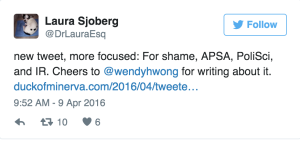The other day, Wendy Wong posted at the Duck of Minerva about race, gender, and having a career in IR – particularly in response to the American Political Science Association’s choice of a stock image of a random Asian woman as the image to advertise their article on authority in International NGOs. Wendy asked a series of important questions: what did this image have to do with authority? or NGOs? Or politics? What happened to her co-author? What search terms led to this picture? Are we still relying on stereotypes that all Asians look alike? How hard is it to google NGOs?
After initially not apologizing, APSA issued an apology, promising to monitor their social media posting better. Still, many of us were horrified that such a ‘mistake’, and all of the stereotypes that brings with it, was even possible for APSA as an organization, given all of the work our field has done on race and gender stereotypes both in scholarship and in the world. My tweet below is only one example:

Political scientists’ anger was picked up by Scott Jaschik at Inside Higher Ed, in a post titled “Twitter Illustration Angers Women in Political Science.” My immediate reaction was to criticize the gender stereotypes inherent in the article title:

A 140-character tweet might not have been the best place to explain it. Several other tweeters, and facebook posters, have expressed discomfort with Jaschik’s wording. Steve Saideman noted in a comment on the post:

Will Moore, on his blog, critiqued the title for suggesting that only women were upset by it, and thereby reifying the normalization and prioritization of white men’s problems over the problems of people who aren’t white men, which are treated as less serious or of lesser import. Wendy Wong and Sarah Stroup suggest a better title for Jaschik’s piece on twitter:

I think that this is an important correction, and that it is important that Jaschik acknowledge it. But I find Jaschik’s title even more insidious than other critics have explicitly because it plays on and entrenches an embedded (masculine) stereotype of the scary “angry woman.”
Narrativized accounts of the “angry woman” frame her as more scary than, and more dangerous than, any angry men could be. Subtly drawing of gender stereotypes, often descriptions of women’s anger suggest that women (who are understood as emotional) have, deal with, and express anger in more unpalatable ways than men (who are understood as irrational). The “angry woman” is characterized as angry at whatever the offending man might do, however justified and possibly even sympathetically intended. The “angry woman” is a way to characterize feminism as hysteria and not a search for justice and emancipation. The “angry woman” distances women from both agency and normal femininity. The “angry woman” is belittling, sexist, and deeply both intellectually and normatively problematic – even when it is not deployed intentionally.
I can’t speak for whether Wendy was angry, because I’m not her. I was angry. However unintentional, APSA’s post was sex and race subordinating, and trivialized Wendy and Sarah’s work. But Jaschik didn’t say that. He might have meant to. Instead, he said that women were angry. He didn’t say APSA made them angry. He didn’t say APSA belittled them. He didn’t say APSA’s mistake trivialized their work. He said that the tweet had “angered women.” And watch out for those angry women …
So, I have two take-aways:
- I think Jaschik needs to apologize for/change the title of the post on Inside Higher Ed.
- “Angry women” don’t come from femininity gone awry –> anger. They come from ridiculous essentialism and subordination –> anger. And a great way to prove the justness of that anger is to stereotype women who stand up for themselves as “angry women.”
In part 2 of this post, I’ll tell you what got me thinking about this a couple of months ago, and how I think of analyzing anger in gender analysis in IR.
